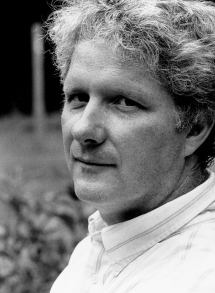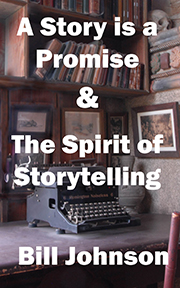| A Story is a Promise |
|
Script Services |
| Essays on the Craft of Writing |
|
|
| About the Author |
From Simplicity to Complexity
A Review of Mulholland Drive
by Bill Johnson

The art of creating a complex story begins with an understanding of simplicity. Take the issue of identity, explored in many stories. The Usual Suspects has Verbal Kint, who embeds a truth in the details of an interrogation room. In Malice, a naïve innocent finds his life turned upside down by his sweet wife who turns out to be a con artist. "Get in the game," the con artist's mother tells the naïve ex-husband now on a steep-learning curve.
The trick in telling these kinds of stories is that the audience be given something clear and immediate to track while the character mutations are going on. A film maker who demonstrates an understanding of misdirection is David Lynch in Mulholland Drive. What follows will be an overview of the main thrust of this complicated film.
The film starts with young couples doing the jitterbug. A spotlight shines on the face of a young blonde girl while we hear applause, which suggests she has won a dancing contest.
The next series of scenes is a car driving along Mulholland Drive in Los Angeles. The car stops and a beautiful, dark-haired woman is told at gun-point to the exit the car. As she starts to get out, some joyriding teenagers hit the car, killing those inside. The young woman stumbles down toward city lights, and finally falls asleep near an apartment on Sunset Blvd.
The next morning, two men chat in a Winkie's fast food restaurant about one man's double dream of meeting evil face to face behind this particular Winkie's. In a sly way, this introduces the idea that evil looms nearby.
The question raised, What will be the face of this evil?
The dark-haired lady ends up in the apartment Betty, the young blonde from the opening scene, is using while her Aunt is off on movie business. Betty hopes to land some good movie roles. When sweet young Betty discovers the mysterious, dark-haired beauty in the apartment, the beauty takes on the name Rita from a movie poster, but it soon comes out that Rita has lost her memory.
The story now has some simple, clear tracks to follow: Who is Rita? Why were the men trying to kill her? Will Betty's dream about making it in the movies come true?
We then go to a meeting where a young director is told he must cast a particular actress for his next film, Camilla Rhodes, or the film will be shut down. The point is made that cryptic, dark forces behind the scenes are controlling what actress will appear in this film. Adam, the young director, is determined to resist this intrusion.
The scene then cuts to a scruffy guy shooting someone in a cheap office, then accidentally shooting a heavy-set woman in the office next door. She assumes some black-hearted bug bite her on the ass. He has to kill her, no easy task, then talk a janitor into the death scene office. The goofy hit man then tries to make it look like the first 'suicide' shot the woman, the janitor, blasted the janitor's vacuum cleaner, then killed himself.
The simple question, Who is this fool working for?
Betty learns that Rita has amnesia and that she's carrying a large amount of cash. There's a blue box with the money. So, we're shown something obvious, the money that helps us track where the plot/story is going, while we also see a more mysterious clue. A particular type of key is needed to open the box.
Betty tracks down some information about an accident on Mulholland while Adam goes home unexpectedly to find his wife in bed with the pool man. In the quick divorce, he ends up with the house, she with the pool man.
Like the amnesia, there's an air of unreality to this quick turn of events, but because the story continues to advance in a thoughtful way, the audience is pulled forward. When a story lacks movement, of moving toward something purposefully, an audience is left with time on their hands to pick apart plot improbabilities.
Adam goes to meet a cowboy who passes along the cryptic message that a 'man's attitude determines his life.' This is a great scene, with the cowboy appearing to speak from a world that finds no amusement in Adam's brand of ironic detachment. He tells Adam he must cast a particular girl for his film. If he does as told, he'll see the cowboy one more time. If not, he'll see him twice more, with the implied suggestion he'll kill Adam.
While this scene is quite cryptic, we can still track what the cowboy wants and intends, and wonder how he came to be involved.
Betty then gets a chance to audition for a second-rate role. While she appears to be a sweet ingénue, she plays the scene as a sexual predator and wins the role. But she's then told the movie she's won a part in will never be made.
Betty and Rita then go to the apartment of Diane, who Betty suspects is Rita. Inside Diane's apartment, they discover a dead body, presumably Diane. This affirms the deadly peril Rita seems to be in.
The question, why were those men in the opening scene going to kill Rita is made more pressing.
Betty then helps Rita dye her black hair blonde and cut it short, so she looks like Betty. Betty also invites Rita to sleep in her bed. They make passionate love, and Betty tells Rita she loves her.
This is an unforeseen twist. Like the quick divorce and the amnesia, it comes across as a movie convention (which speaks to where this story is headed).
That night, Rita begins to speak in Spanish. She insists there's somewhere she and Betty must go. They end up at a spooky night club where an MC insists the evening's performances are taped, that all is an illusion. A singer faints during a song and the song continues to play. Both Betty and Rita cry and appear shaken up.
Back at the apartment, Rita takes out a blue key. Betty is suddenly gone. Rita opens the box. The inside of the box is blackness.
Meanwhile, the cowboy stands at Diane's bedroom door and tells her dead body to 'wake up.'
Later that morning, Betty is now Diane, Rita is the dark-haired Camilla. What has been developing in the background - who is Rita, who is Diane -- now takes center stage.
Now, when Diane/Betty wants to be intimate with Camilla/Rita, she's told they shouldn't, which upsets Betty. In the next scene, they are both on a movie set with Adam. Camilla/Rita is the star, and it's clear she and Adam are involved, which continues to upset Diane/Betty.
Even thought both characters have transformed, what's at stake for each is still apparent. We know what getting a good role in a movie means/meant to Betty/Diane, and something of the dreary life she's led since Camilla got the part she wanted.
Camilla then calls Diane and tells her a car is waiting to take her to a destination on Mulholland Drive. Is the story circling back to the beginning? Instead Diane ends up accompanying Camilla to a party at Adam's, where Camilla and Adam are set to announce their engagement. Diane/Betty's loss is double, losing the movie role and the relationship with Camilla.
It comes out that after Diane won the jitterbug contest, she also had some money from an Aunt and Uncle who died (who have made several strange appearances in the movie).
Cut to Diane at Winkee's with the goofy hit man (and a waitress named Betty). Diane hires the goofy hit man to kill Camilla.
The story has been Diane's revenge fantasy run amok.
The blue box is opened, and the older couple come out and chase Betty. She fires a gun.
In Winkee's, Diane notices the man from the opening scene, who knew that evil was behind Winkee's.
We then see the eyes of the man behind Winkee's, the eyes of darkness, the destroyer of dreams. Next we see Diane, young and glowing when she won the jitterbug contest.
Even while this story appears to be advancing on one track around Betty getting a good role in a movie and discovering who Rita is, something is always developed in the background about illusion, evil, dreams and identity. As the shift in the characters of Betty/Diane and Rita/Camilla picks up speed, that underlying track comes fully into view.
In hindsight, the purpose of the veiled suggestions and the use of stock movie conventions make sense.
This is a powerful story.
One way to create this kind of story is to take an issue like identity, figure out the basic twist and ending, then work back to the beginning, making decisions about what needs to be revealed when. The crux is to always give the audience a path to track, to give scenes a dramatic purpose and outcome.
I'm often asked if this type of story has two story lines. The answer is no. A movie/story plays out one frame at a time. No matter which direction in time is suggested, whether the action of a story is rooted in 'real' life, in dream time, or in emotional time, a story needs to advance in a way that serves the storyteller's dramatic intent. Otherwise, a story suggests a storyteller's confusion.
In his career going back to Eraserhead through The Straight Story, Lynch has shown himself to be a master of telling stories both bizarre and the heartfelt, simple and complex.
(This article appeared in ScreenTalk, The International Magazine of Screenwriting.)
Top of page